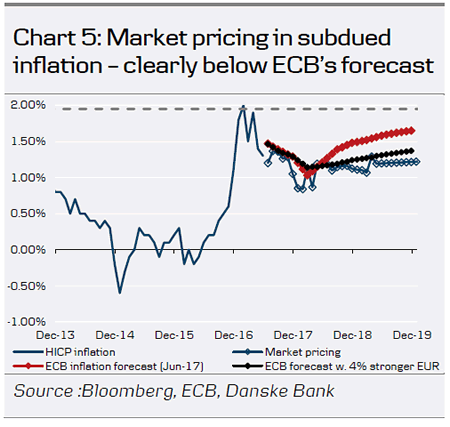Key points
- Euro appreciation is a headwind to inflation and a downward revision to the ECB’s forecast should keep inflation far below the target.
- The weaker inflation outlook is likely to keep the ECB on a dovish path, especially as the latest rise in core inflation is not sustainable.
- The risk is that ECB will stay hawkish as it needs an ‘excuse’ to taper QE given that technical restrictions are again challenging a QE continuation.
- Lack of wage pressure should imply the ECB’s exit path will be very gradual, hence the pricing of rate hike is aggressive.
A combination of ECB and Fed communication and the balance of political risks has shifted in favour of the euro, which in effective terms is 4% stronger compared to the assumption in the ECB’s projection from June 2017 (see Chart 1). The euro appreciation will be a headwind to headline and core inflation in coming years where the ECB’s inflation projection – particularly considering the longer forecast horizon – already seems optimistic. Based on the OECD’s new global model, the 4% stronger effective euro will drag down headline inflation by around 0.1pp after one year and an accumulated 0.3pp after two years. Given the ECB’s inflation forecast update from June, this should result in an inflation forecast of 1.2% for 2018 and 1.3% for 2019, all else being equal (see Chart 2). Note that we forecast even higher EUR/USD in the longer term, targeting 1.22 in 12 months.
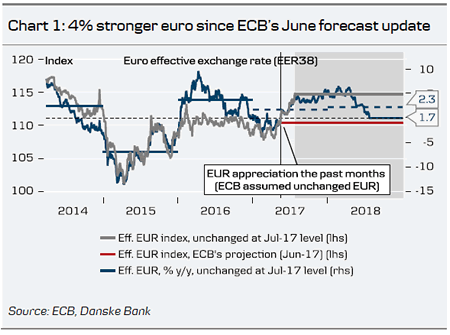
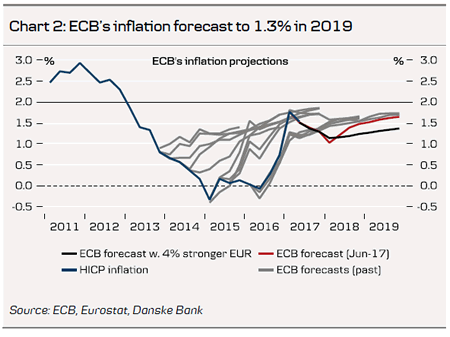
Inflation at 1.3% in 2019 is clearly below the ECB’s 2% target for the medium term, implying that pressure on the ECB for expressing a dovish stance is rising. The market is still pricing in a 10bp deposit rate hike at the end of 2018, which in our view is too early as the ECB is likely to continue QE at least until mid-2018 even in a fairly aggressive tapering scenario, after which we expect it to stick to its communication and not hike until ‘well past’ the QE purchases. It could be the ECB will hike by 20bp (priced in May 2019) but based on the ECB’s communication that it will be very gradual, a 10bp deposit rate hike seems most likely and the pricing still seems too hawkish.
We still believe the ECB will continue its QE purchases, but at a reduced pace of EUR40bn per month in H1 18, and that it will announce this at the October meeting with some signalling of it in September. Although an inflation forecast of 1.3% for 2019 is very low, the ECB’s recent hawkish shift in focus to the improving economic recovery and its belief that this will result in higher inflation eventually suggest to us that the trigger for a more aggressive QE path currently also hinges on a weaker growth outlook.
Related to the ECB’s recent hawkish shift, the risk is that the ECB will look through the downward pressure on inflation and express a hawkish stance due to the ongoing economic recovery. In particular, when Mario Draghi speaks together with other global central bank governors at the Jackson Hole symposium on 24-26 August, he could be perceived as hawkish. However, when the ECB’s updated inflation projections are released at the ECB meeting on 7 September, the focus should be on the stronger euro, as it received some attention at the latest meeting already and as Draghi said a financial tightening was ‘the last thing’ the ECB needs.
In our view, the ECB’s hawkish twist towards the economic recovery could reflect that the ECB is trying to find an ‘excuse’ to taper QE (see chart 3). While the ECB has not indicated it can end QE due to a sustained adjustment in the path of inflation, the capital key deviations suggest the self-imposed restrictions are again becoming binding thereby challenging a continuation of QE. The ECB has previously resolved this by tweaking the rules, but the pressure for doing so again is much smaller as the deflation risk is gone. Hence, the ECB might continue to focus on the growth momentum and its belief that this will result in higher wage pressure.
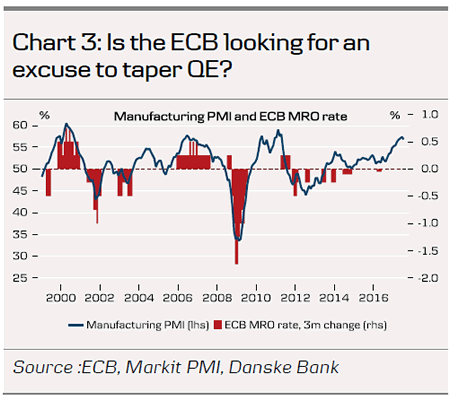
What is supportive of the hawkish twist is the higher core inflation, which was 1.1% in Q2, up from 0.8% in Q1. However, looking into the drivers of the higher core inflation, the rise has been driven by components that are volatile and do not reflect a pickup in underlying price pressure. Excluding package holidays and accommodation as well as services related to transport reveals that core inflation was actually on a downward trend during 2016 and only stabilised recently (see Charts 4 and 7). As the higher inflation in services related to transport reflects an indirect impact of the oil price base effects, this is likely to be a temporary rise – as long as wage pressure remains subdued.
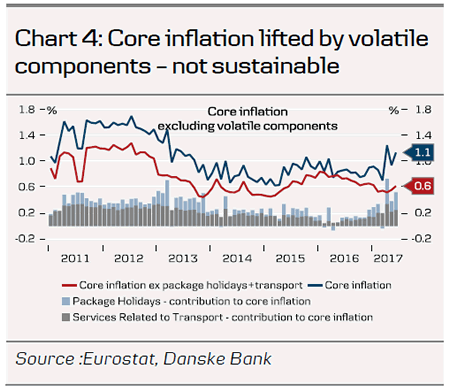
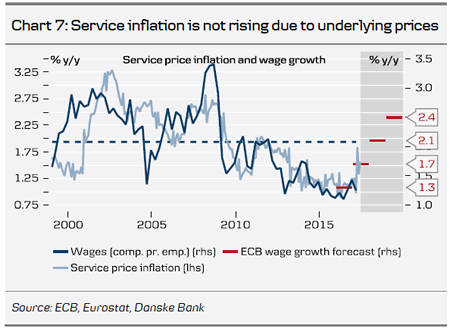
There are still no signs of rising wage pressure and the ECB’s projection for wage growth still seems very optimistic. Given the subdued wage growth in Q1, wages need to grow by 0.55% q/q for the rest of the year to reach the ECB’s projection. Since 2010, wages have on average risen by 0.37% q/q and given the remaining slack in the labour markets, it is in our view hard to believe in the ECB’s forecast (see Chart 6). Note, the ECB argues that slack in the labour market amounts to 18% of the extended labour force.
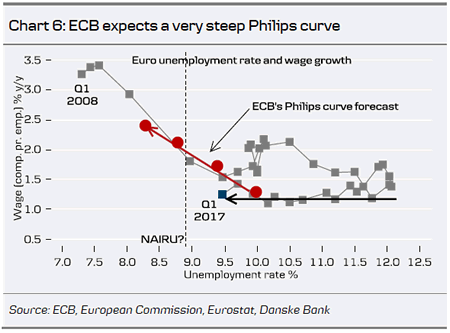
Note, the first euro area inflation figures for July are due for release tomorrow with the German, French and Spanish figures. The euro appreciation during July should not yet result in lower inflation (we expect to see the impact on core inflation after six months), but we look for the German figure to go lower as package tours are likely to have been less supportive. This should lead to a decline in euro area HICP inflation to 1.2% in July from 1.3% in June and in core inflation to 1.0% in July from 1.1% in June, due for release on Monday. In line with our expectations, the market is pricing in a subdued outlook for inflation, which is clearly below the ECB’s forecast of a rise in inflation but more consistent with the path following from the 4% stronger euro (see Chart 5).
